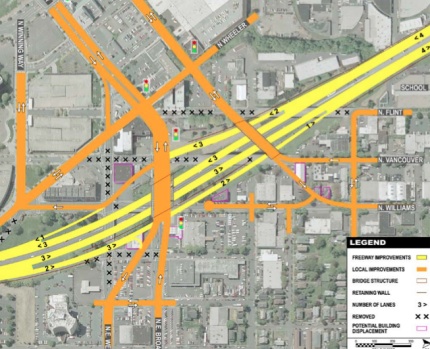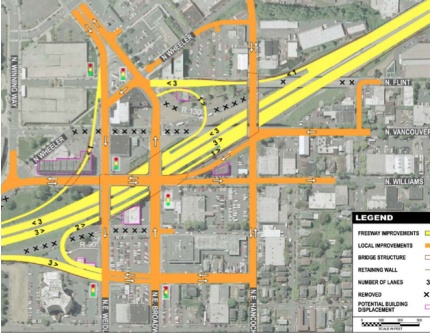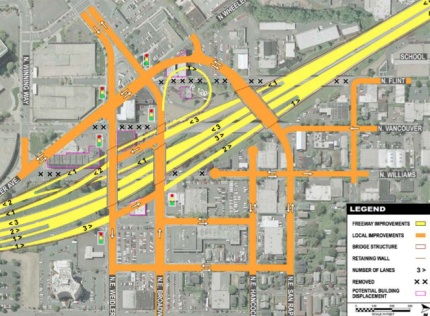
A new A report (PDF) prepared by consultants for the Oregon Department of Transportation (ODOT) and in partnership with the City of Portland shows that the agency might be trying to build momentum for widening I-5 between the I-405 and I-84 interchanges. Ideas detailed in the report would also come with major changes — including the potential displacement of buildings and new bridges over I-5 — to local streets in the area.
[UPDATE (12/15) : The concepts in the report were developed in 2007, but are now being put forth as “starting points” in the N/NE Quadrant planning process. This is the first time the public has seen the concepts developed in the report.]
The four concepts detailed in the report would all have dramatic impacts on bicycling, walking and motor vehicle traffic flow.
According to the report (PDF here), this section of I-5 — because it’s used by all three freeways and has “only” two lanes in each direction — is “the most significant bottleneck in the Portland freeway system.” The report’s “Problem Definition Summary” lists several other reasons for making changes (which might sound familiar if you’ve been following the Columbia River Crossing project):
- The design is substandard to handle existing and projected volumes.
- The proximity of on and off movements creates too-short weaving distances.
- The number of rear-end crashes are high…
- Land use changes are increasing the demand for access to the area…
- Ramps off of I-5 lead to narrow cross streets with little excess capacity.
- The freight community has publicly stated that the congestion in this section is one of their highest priorities for improvement.
Four separate concepts are detailed in the report and all of them include potential displacement of buildings, removal of existing streets, new vehicle bridges over I-5 and additional freeway lanes. Below are detail images of the four concepts along with notes from the report about biking and walking impacts…

This concept would add a new overcrossing where Vancouver meets I-5. “Bicycles and pedestrians could also utilize this new crossing without crossing the interchange ramps at Broadway. It would also be possible to construct a new pedestrian crossing of I-5 one block south of Broadway into the Rose Quarter.”
——

“… the new overcrossing that combines the Williams/Vancouver one-way couplet and Hancock. Bicycles and pedestrians could also utilize this new crossing, thereby completely avoiding conflicts with the interchange ramps at Broadway. Also proposed is a new pedestrian crossing of I-5 one block south of Broadway into the Rose Quarter.”
——

“… new overcrossing that is on the existing Williams alignment. Bicycles and pedestrians could also utilize this new crossing without crossing the interchange ramps at Broadway. Pedestrians and bicycles could also use the new Hancock overcrossing of I-5. As with the other alternatives, a new pedestrian crossing of I-5 one block south of Broadway into the Rose Quarter would also provide pedestrian access across I-5 into the Rose Quarter.”
——

“… the new overcrossing that combines the Williams/Vancouver one-way couplet and Hancock. Bicycles and pedestrians could also utilize this new crossing without crossing the interchange ramps at Broadway. Proposed also is a new pedestrian crossing of I-5 one block South of Broadway into the Rose Quarter.”
——
The report’s authors (it was created by CH2MHill, but no individuals are listed in the report) says that this planning effort should be characterized as “‘homework’ to determine if there are one or more feasible and acceptable alternatives.”
Mindful of the significant impact these proposed concepts would have, the report states:
“While there certainly are some impacts to community goals and urban fabric, there are also many opportunities for enhancing those goals. Those include better local access to adjacent land uses, opportunities for new development, more open space potential, better non-auto local circulation, better neighborhood connectivity, and no significant visual impacts.”
The area, part of the “Freeway Loop,” has been studied for years. Now, with the start of full-scale planning and public processes for the N/NE Quadrant and I-5 Broadway/Weidler Plans, ODOT and the City of Portland want to make sure that their ideas are part of the picture.
— Download: I-5: I-84 to I-405 Design Workshop Concept Report (PDF)

